I found some of the behaviors surprising and even a little perplexing.
All images are presented in the order they were taken.
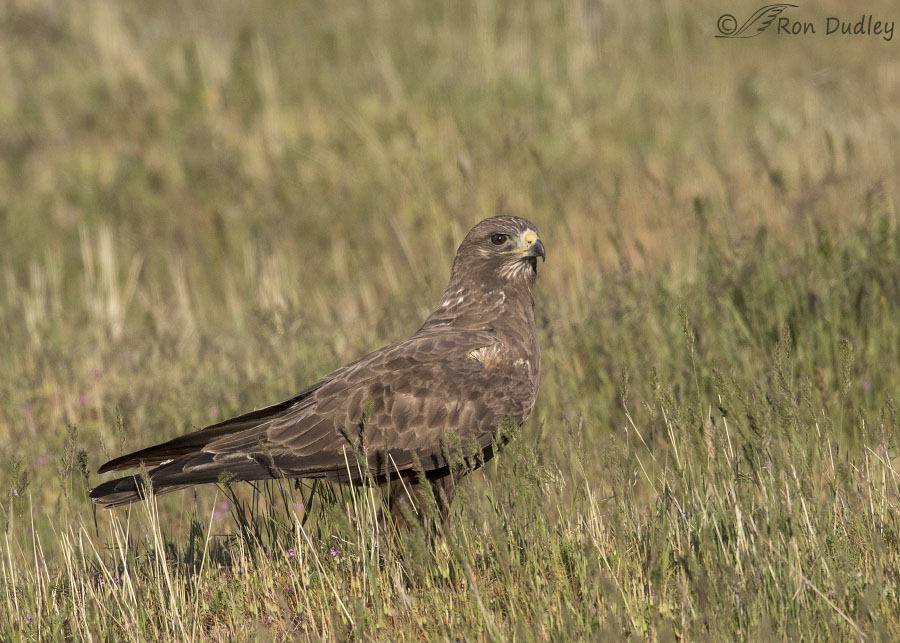
1/3200, f/6.3, ISO 800, Canon 7D Mark II, Canon EF 500mm f/4L IS II USM + EF 1.4 III Extender, not baited, set up or called in
Three days ago this Swainson’s Hawk (to me the hawk appears to be intermediate between a dark morph and an intermediate morph) flew across the road behind my pickup and landed with a whoomp in the grasses behind me and to my left. At first I didn’t know its sex for sure but as you’ll see it soon became apparent that it was a female. I believe she had been after prey when she landed but for a while I couldn’t tell if she had been successful because the grasses blocked my view.
In the meantime her mate landed on a power pole perhaps 100 yards further to our right.
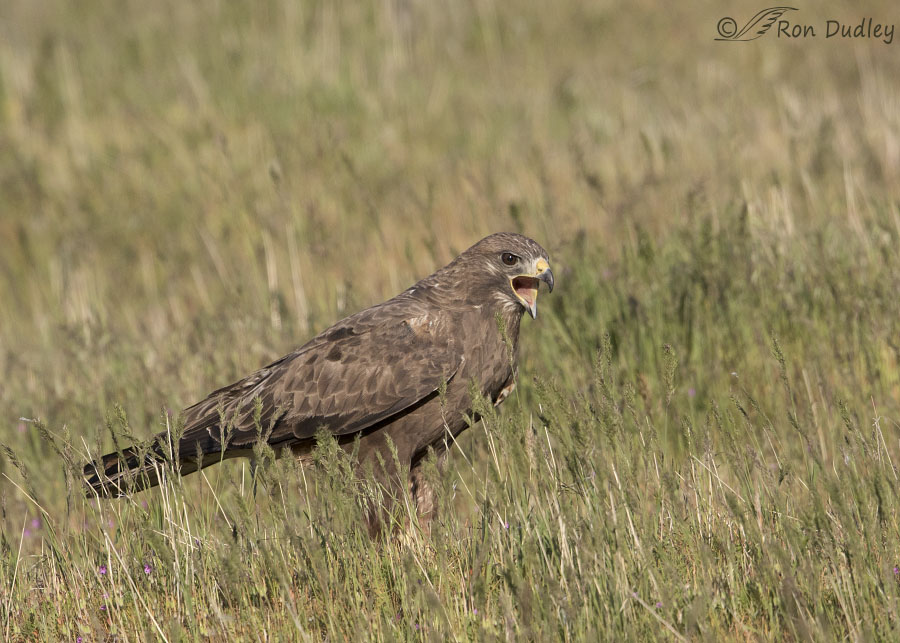
1/2000, f/6.3, ISO 640, Canon 7D Mark II, Canon EF 500mm f/4L IS II USM + EF 1.4 III Extender, not baited, set up or called in
She mostly just stood there stoically at first but soon she began calling to her mate on the pole. At one point a couple of male Northern Harriers flew over and her calling may have been directed at them for a few moments but most of the time she was obviously calling to her mate.
And soon it became obvious that she had prey when she lifted an open foot and tried to drop a vole to the ground. The vole, impaled on her talons, refused to drop for a few moments and it was comical to watch her attempt to release it. Eventually it fell.
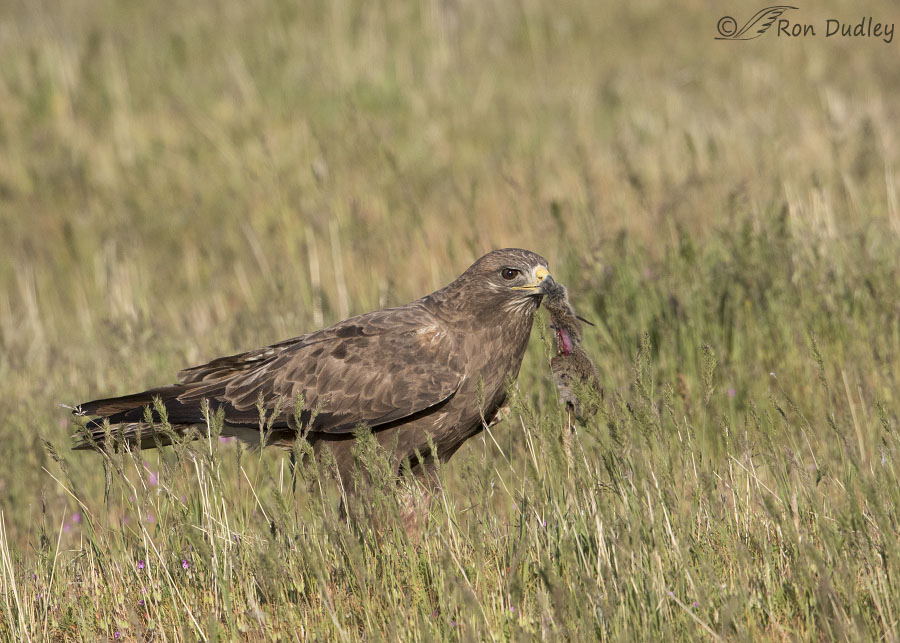
1/2000, f/6.3, ISO 640, Canon 7D Mark II, Canon EF 500mm f/4L IS II USM + EF 1.4 III Extender, not baited, set up or called in
In two swift motions she eviscerated the vole (it was an incredibly fast and efficient operation) and I saw her drop the entrails to the ground. But I had my lens on her the entire time and while she was on the ground she never did eat anything. Here she picked up the gutted vole but she soon dropped it again.
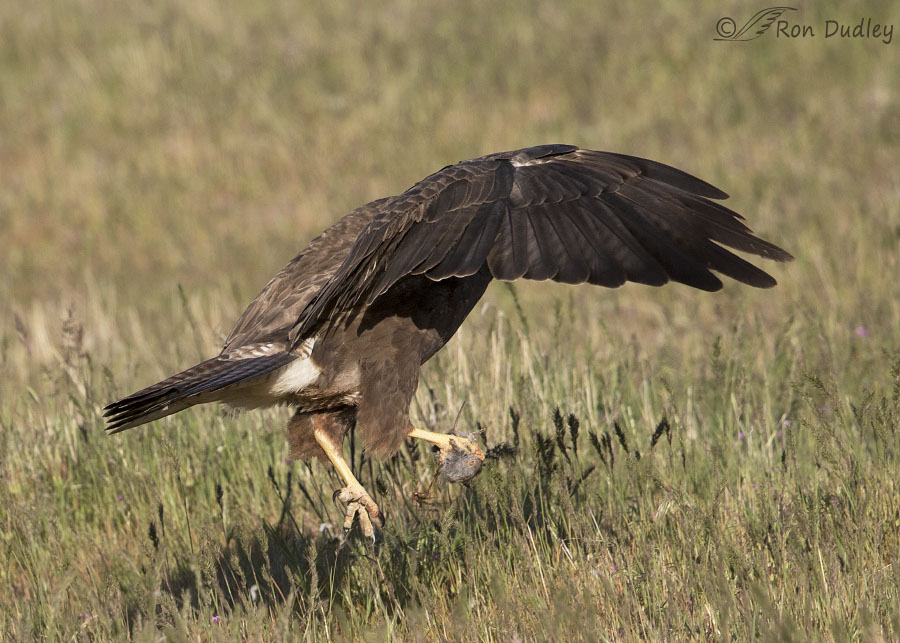
1/2500, f/6.3, ISO 640, Canon 7D Mark II, Canon EF 500mm f/4L IS II USM + EF 1.4 III Extender, not baited, set up or called in
At one point she grabbed the vole in her right foot and then hop-flew a few feet to my right and slightly closer to her mate on the pole and then settled down into the grass again.
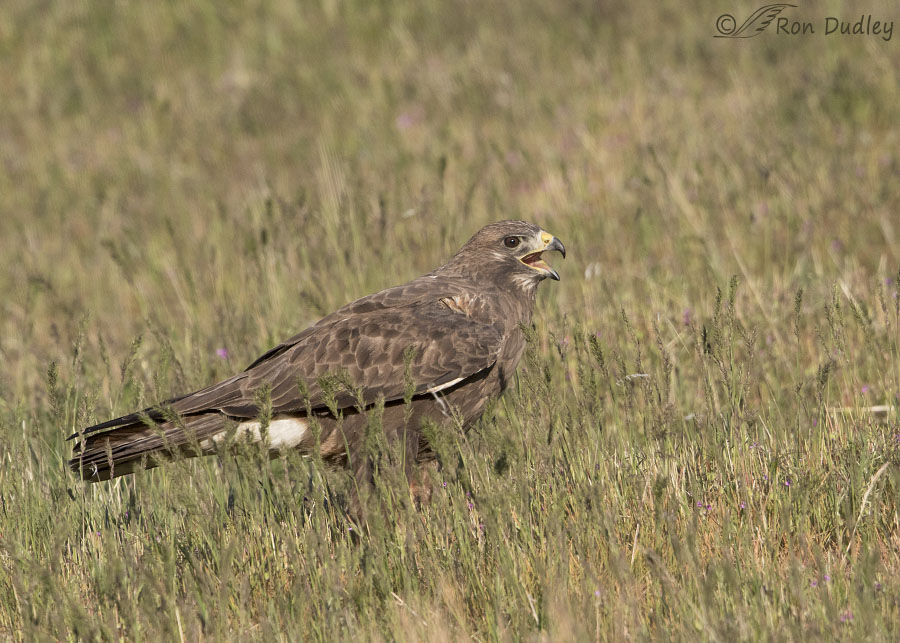
1/2500, f/6.3, ISO 640, Canon 7D Mark II, Canon EF 500mm f/4L IS II USM + EF 1.4 III Extender, not baited, set up or called in
And then her calling to her mate on the pole intensified. I was hesitant to take my lens off her and document the far-off male for fear I’d miss her takeoff but eventually I chanced it and …
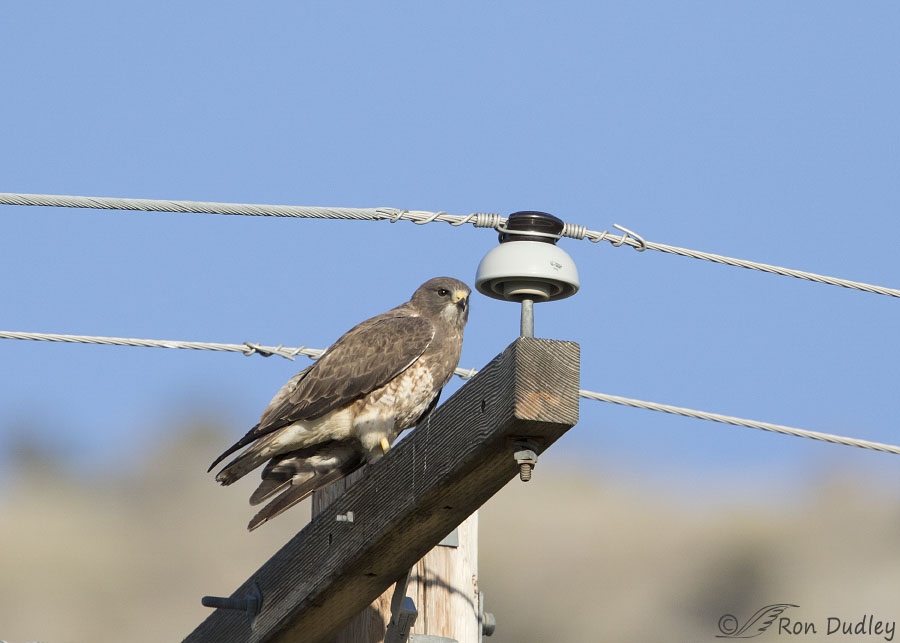
1/2000, f/6.3, ISO 640, Canon 7D Mark II, Canon EF 500mm f/4L IS II USM + EF 1.4 III Extender, not baited, set up or called in
popped off a few quick shots of him on the pole (he was a light morph Swainson’s).
At that point I decided to move my pickup forward so I’d be between the two hawks and closer to the male but of course she chose that interval to take off and land in the grasses beneath and to the left of her mate so I missed getting takeoff photos of her as she did so.
The photos that follow are of documentary quality only – both birds were far away and the female in the grass was behind a slight hill so I could barely see her.
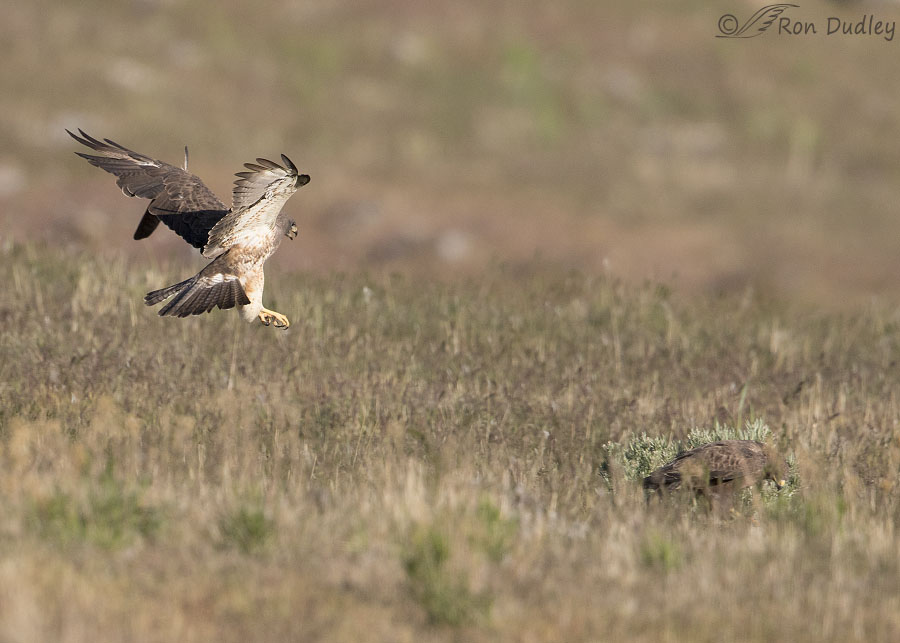
1/2000, f/6.3, ISO 640, Canon 7D Mark II, Canon EF 500mm f/4L IS II USM + EF 1.4 III Extender, not baited, set up or called in
The male took off from the pole, circled around behind the female, and swooped in with the obvious intention of landing on her back for mating (as you can see she has already assumed a Solicitation Posture).
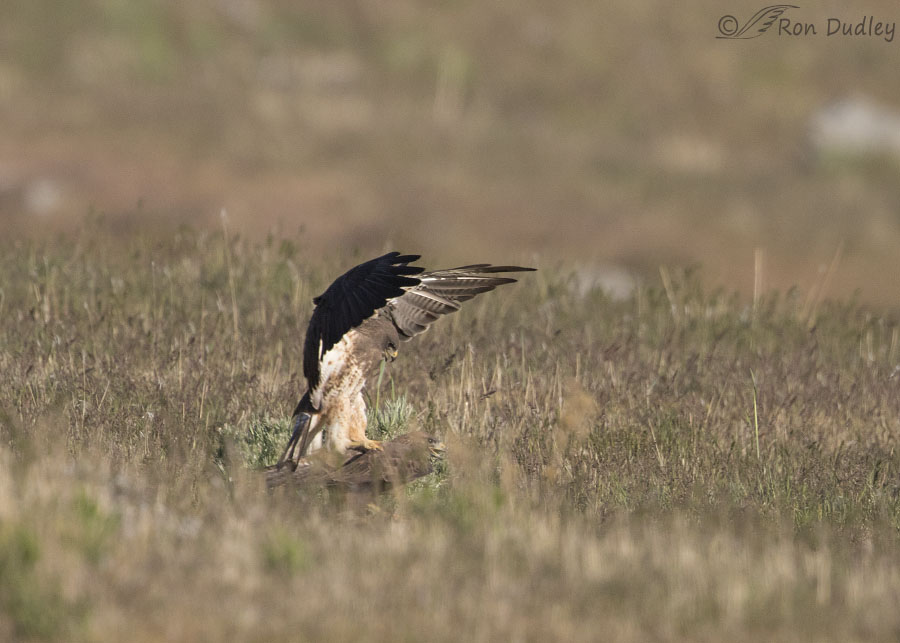
1/2000, f/6.3, ISO 640, Canon 7D Mark II, Canon EF 500mm f/4L IS II USM + EF 1.4 III Extender, not baited, set up or called in
And that’s exactly what he did – this photo was taken just as he was landing.
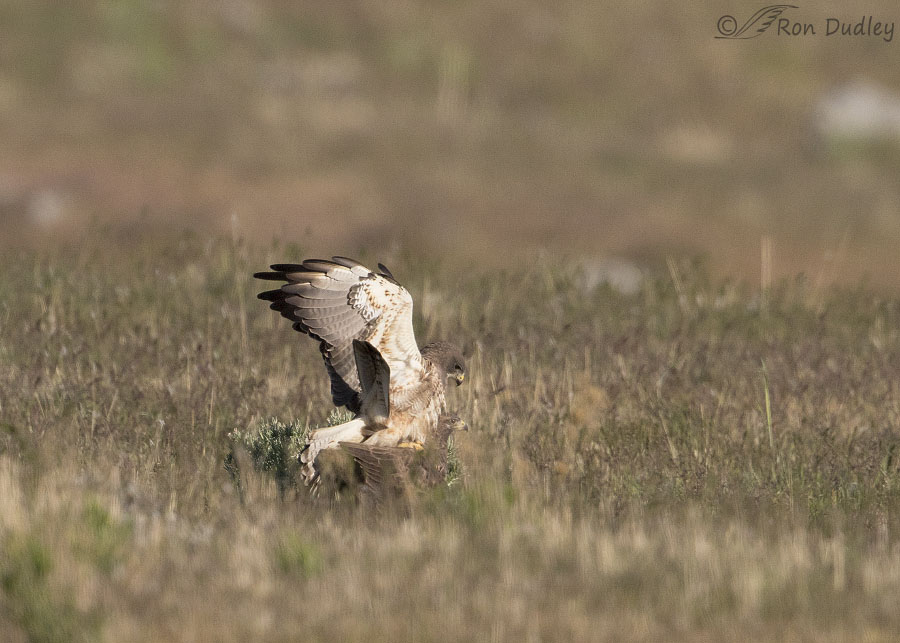
1/3200, f/6.3, ISO 640, Canon 7D Mark II, Canon EF 500mm f/4L IS II USM + EF 1.4 III Extender, not baited, set up or called in
They proceeded to mate. I got many shots of the process but my active focus point kept trying to grab onto the grasses in the foreground so some of them were quite soft. After the mating the male returned to the pole…
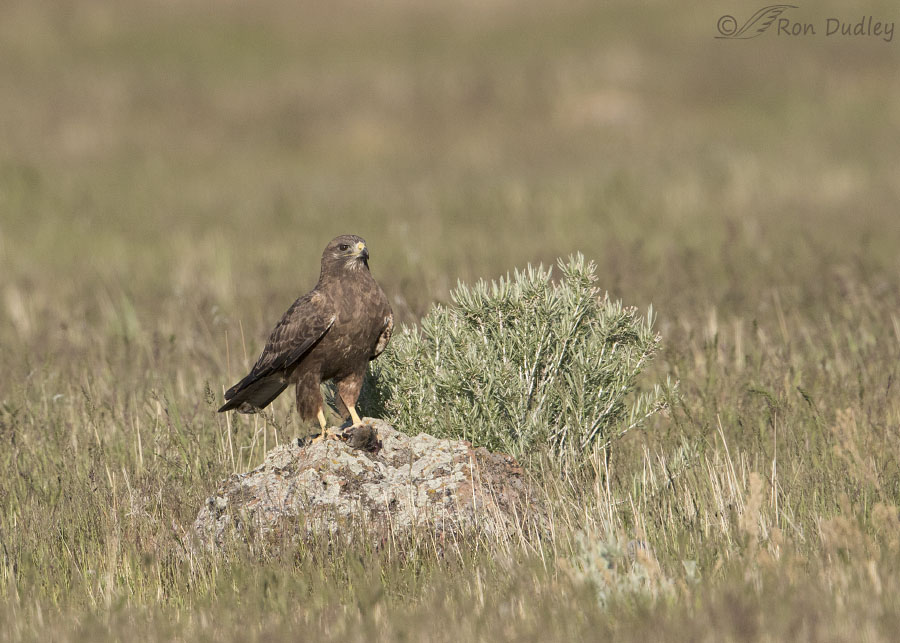
1/2500, f/6.3, ISO 640, Canon 7D Mark II, Canon EF 500mm f/4L IS II USM + EF 1.4 III Extender, not baited, set up or called in
and the female took the vole to a nearby rock…
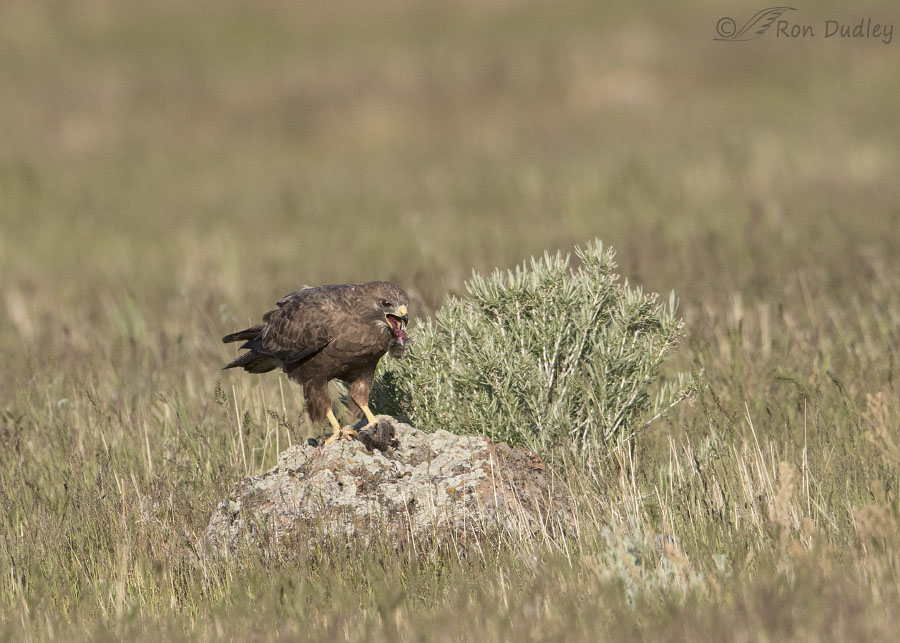
1/2500, f/6.3, ISO 640, Canon 7D Mark II, Canon EF 500mm f/4L IS II USM + EF 1.4 III Extender, not baited, set up or called in
where she gobbled it down in big chunks. But she paid a price for her “gluttony” because…
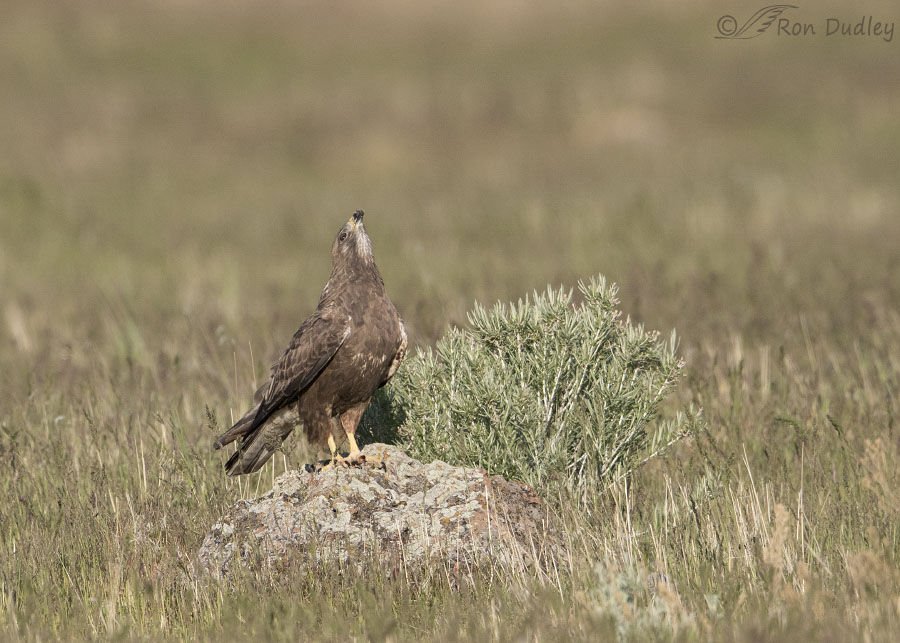
1/2500, f/6.3, ISO 640, Canon 7D Mark II, Canon EF 500mm f/4L IS II USM + EF 1.4 III Extender, not baited, set up or called in
she really struggled to get the last chunk down her gullet. She repeatedly stretched her neck and pointed her beak skyward at an extreme angle and several times she even “scratched” her neck with her right foot in an apparent attempt to massage the chunk of food down her throat. She repeated both actions for perhaps 10 seconds before she was successful in getting the food down to her crop.
After that she stayed on the rock and the male remained on the pole. Since they were far away I left the area.
In my experience at least two aspects of these behaviors were new to me, including:
- Why did the female apparently and intentionally mix food with sex? My first impulse was to suspect the vole was intended as a “nuptial gift” as part of a behavior known as courtship feeding. Many animals do this, including some bird species, but as far as I know it’s always the male bearing the gift instead of the female and besides this female never “gifted” the vole to her mate anyway. Maybe his only current appetite was for sex so he refused the vole? I just don’t know…
- I’ve often seen raptors struggle to get food down their throats and sometimes they even seem to choke on it a little but I’d never before seen one repeatedly stretch its neck vertically at such an extreme angle and then, also repeatedly, try to “massage” the food down with its foot.
Unusual and unique (to me at least) behaviors like these are just one of the reasons I’m fascinated by birds and love to photograph them. They help to make my life more interesting.
Ron


This is a very interesting series. which shows the great value of sitting and watching the birds. Bird behavior is always interesting.
It sure is, Susan. And sometimes it’s even something new!
A beautiful bird…I do much prefer the dark morph of the species. This is a hawk that is very rare in this area…only a few recorded sightings. It reminds me of the Rough Legged in someways. I think they too have a ‘gentle’ look about them if that is possible for a bird of prey?
I watched similar actions going on this morning between two Cardinals…she was feeding him seeds…ever so gently, rubbing beaks with him, and then she flew off and he in pursuit. Perhaps it is true ‘The way to a man’s heart is through his stomach’. What can show more interest than taking the time to prepare a meal…
I agree, the dark morphs are pretty special, Kathy. Thanks.
I am so grateful to learn, and wonder and marvel here. Birds so often don’t read THE book. And I love that you are able to pick up on that. And share it.
Thank you, EC.
Another intriguing series, Ron! Of course, I have no answers to the behavior. I just come here for the pictures …
And what wonderful photographs they are. I’ve never seen a Swaninson’s and they are incredibly beautiful.
Thanks very much, Wally.
Oh Ron, it’s so apparent what was going on.
Her: Get down here. I’m ovulating and I’m hungry.
Him: No, you are super cranky when you are hungry.
Her: Don’t make me fly up there. You know you can’t balance on me and that pole.
Him: See? Cranky!
Her: 1, 2,
Him: I’m here.
Her: Now it’s time to eat.
Him: I’m going over here where it’s safe.
Her: I love you, honey.
Him: I guess you ate?
Ha, you may be right, Arwen!
Sounds about right to me. Even if the male sounds ‘cluier’ than many.
“Cluier” – you’re a wordsmith, EC!
HAHAHAH They’ve been together for years, EC. YEARS. He’s learned.
He’s learned.
She’s a real beauty! I’m also a sucker for chocolate. Thank you for such a fascinating series; there’s always something to be amazed by! Hopefully, the mating was successful and there will be some babies soon. I agree with Laura about the talons — so fierce and yet so gentle.
Thank you for such a fascinating series; there’s always something to be amazed by! Hopefully, the mating was successful and there will be some babies soon. I agree with Laura about the talons — so fierce and yet so gentle.
I’ll be watching for their nest, Marty – that’s for sure.
Outstanding photos Ron – beautiful birds and exciting to watch their activities. As you mention here, I hate it when the camera insists on focusing on the grass weeds, reeds, etc, instead of your intended target. But you overcame all the obstacles to get these beautiful shots.
Everett Sanborn, Prescott AZ
Thanks very much, Everett.
Jeesh, your behavioral series are just spectacular and utterly fascinating. There’s always something new to learn, and I LOVE it when a behavior is documented that goes directly against the (often self-proclaimed) “experts.” A whole lot more goes on in The Great Out There that humans have never seen, primarily because it’s simply not available to see all the behaviors of every individual out there.
As for the choking issue, in my admittedly teeny tiny (or insignificant) statistical sample, I’ve seen that if the chunk is too big to swallow, they’ll generally hork it back up and try again, either with the whole thing, (one more try) or by ripping it into smaller pieces. But again, we get back to that statistically insignificant sample.
It’s hard for me to believe that they could massage their throat/crop with those sharp talons, but then again, I continually wonder how they can scratch their heads without slicing it to bits. So what do I know? Certainly, I do NOT know it all–I know just a tiny sliver of it all, and by tiny, we’re back to that statistically insignificant thing again.
The rest of the questions remain a quandary, other than the female wanted the male right this second! Beyond that, I don’t have a clue.
Oh and I’m with Judy on the dark morphs. I’m a fool for the darker hawks…OK, who am I kidding? I’m a fool for all of them, but the dark morphs really excite my soul, much like chocolate. HEHE!
Laura, Of course I don’t know for sure that “massaging” or something similar to it was what she was really doing but I can think of no other explanation that makes any sense at all, given the circumstances and what I saw. Wish I could ask her…
Wow.. that’s pretty new to me also .. I have swainsons on my property and they arrive at same time and hang out together before breeding .. is it possible she lost her mate and was trying to entice another one?? Oh and I nicknamed them Screamers .. they are always screaming .. vey noisy hawks .
I don’t know the answer to your question, Marina. I’d be surprised if that was the case but I’ve been surprised before.
Yes, they’re a very vocal species.
Well done, Ron! That’s what’s so fascinating about birds- so many unanswered questions! Thanks for another informative post.
Agreed Diane. If we knew everything there is to know about birds they would be far less interesting (although I’m sure I’d still be a bird fan…).
Wonderful shots Ron, just great behavior views!
Man, I understand the problem with active focus points. So far my only solution is to keep the points narrow, but that doesn’t always work, especially when there is a branch or grass right in front of the subject. If I move slightly so might the subject, so I have to go with what I’ve got at the moment.
Keeping focused is a challenge, Dick – especially when the subject is moving or there are obstructions between photographer and bird. Or both.
If only I had the time to drive somewhere out west to see these birds. Amazing shots, you’d think with all the removal of things like fur and feathers they wouldn’t risk choking, so perhaps it decided to wolf down some food without properly ridding it of inedible parts and choked because of it? Only a guess.
-Xavier
Thanks, Xavier. She didn’t remove any fur, only the intestinal tract. So the chunks were large and I doubt that the hair made theme go down any easier.
This was a fascinating series…raised far more questions than it answered, though…like why was she calling to her mate? Why did she drop the vole? What did she expect the male to do? Was she expecting him to eat the vole? Was he already stuffed? Did she have trouble downing the vole because she had already fed? Did she need to expell a pellet?
I know. I have some of the same questions…
VERY interesting, Ron…. Just when you think you understand them……….;) I wonder if they ever do choke on their prey? Darn grass/twigs can certainly play hell on focusing for sure..:( The dark morph coloration is always beautiful to me – probably my “chocolate thing” On another note I saw a meadowlark “perched” on top of some wheat stubble stalks yesterday – a first that I’ve noticed and interesting in light of your series on one landing on the sage brush.
On another note I saw a meadowlark “perched” on top of some wheat stubble stalks yesterday – a first that I’ve noticed and interesting in light of your series on one landing on the sage brush. 
Loved your chocolate reference, Judy. As you know, I agree!
I’ve also wondered if they occasionally choke to the point of danger. If so I don’t think I’ve seen it. In my experience they often have significantly more trouble getting pellets up their throats than they have getting food down.
Ron – this was another of your fantastic photo presentation of bird behavior. You are such a very talented and sharing individual. I always look forward to seeing your great posts appear each morning in my inbox. I appreciate that you have retained your teaching skills and have transferred them to the internet. Thanks…
Your comment is much appreciated, Mark. I never know how rusty my teaching skills might have become over the years of my retirement so I find feedback like yours encouraging.
I should be so “rusty” IN the classroom, Ron!
Rusty? You. A rusty teacher doesn’t attract (and keep) rusted on followers.
Well said Mark. I have been retired from my field over 10 years now, so I can appreciate your concerns about getting rusty, Ron. Excellent post which I enjoyed very much.